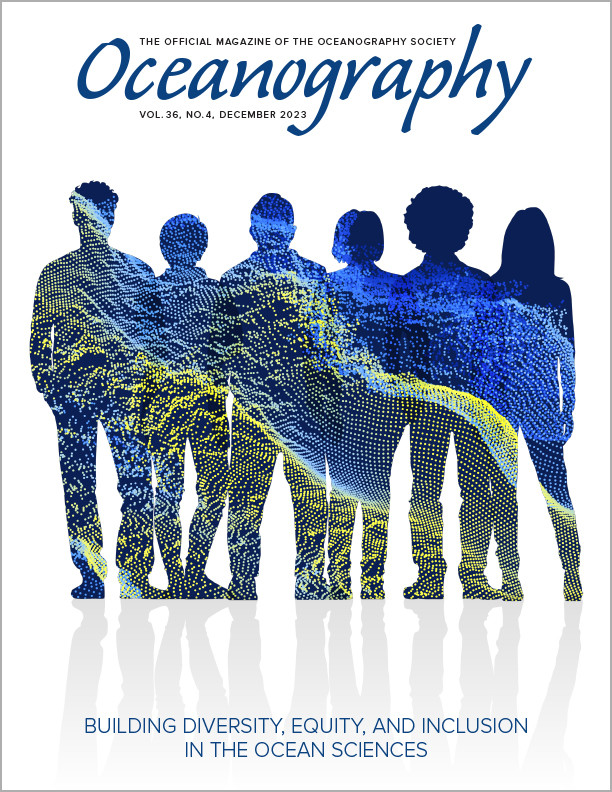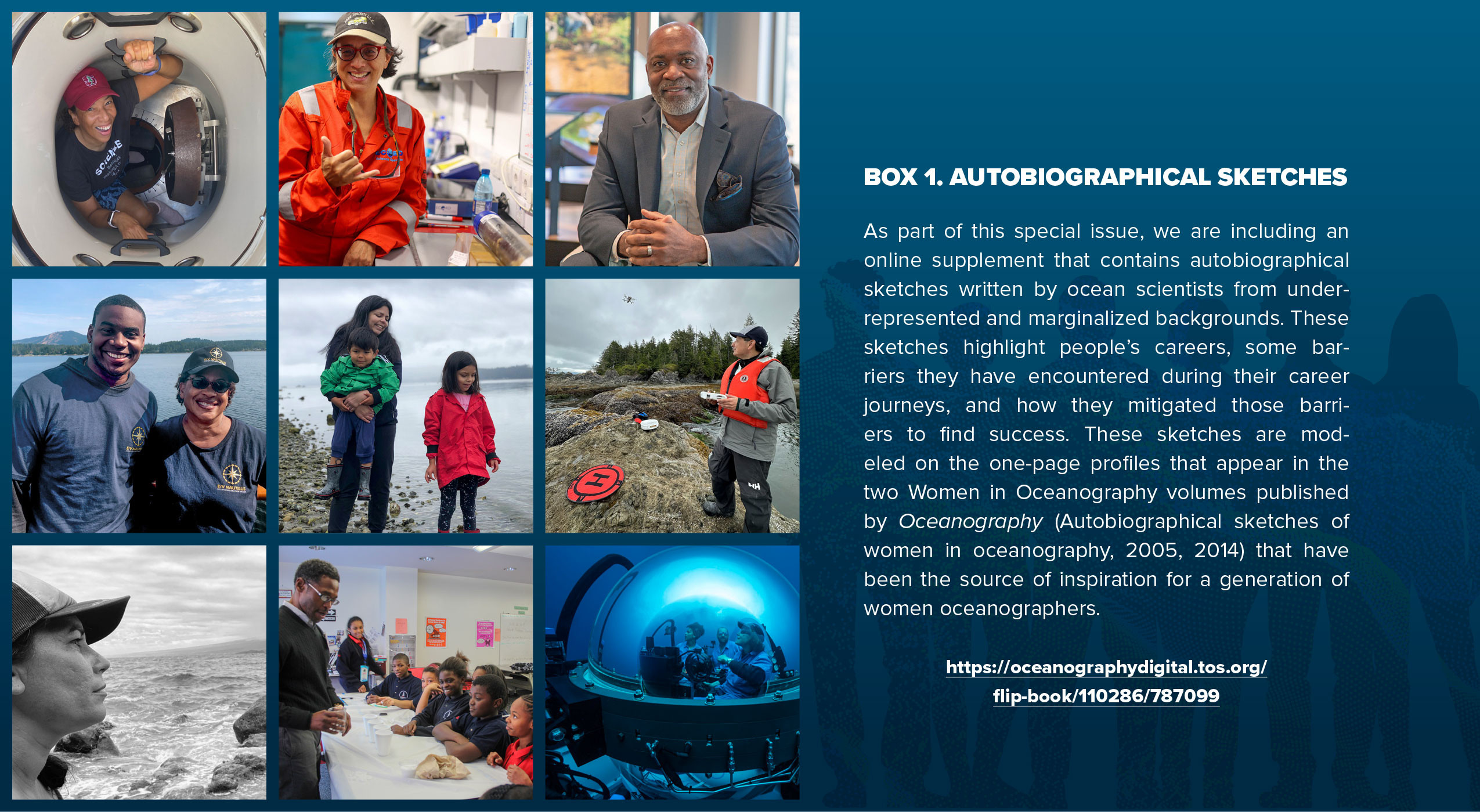Full Text
Why this Special Issue Now?
In his inaugural “The Oceanography Classroom” column for Oceanography in 2000, Dean McManus noted: “A particular challenge for higher education is to include more members of underrepresented groups in the study of the ocean. Fifteen years from now, 40% of the traditional undergraduate-age population will consist of these underrepresented groups, but today the ocean sciences have the lowest participation by underrepresented groups of any science” (McManus, 2000). Why should we care about this lack of diversity in the ocean sciences? As a recent US National Science Foundation report puts it, “A diverse workforce provides the potential for innovation by leveraging different backgrounds, experiences, and points of view. Innovation and creativity, along with technical skills relying on expertise in science, technology, engineering, and mathematics (STEM), contribute to a robust STEM enterprise” (NSF, 2023a). To put it more succinctly, “diversity is not distinct from enhancing overall quality—it is integral to achieving it” (Gibbs, 2014). Having a diverse, inclusive, and equitable workforce is not only a valuable objective and moral imperative, it is essential for fulfilling future workforce needs.
We are now more than 20 years beyond the McManus column, and the numbers have only slightly improved. While gender diversity has significantly increased in the ocean sciences during that timeframe (Orcutt and Cetinić, 2014; Lima and Rheuben, 2021; Legg et al., 2023), the same cannot be said for other historically underrepresented and marginalized groups (identified in various parts of this special issue as Black, African American, Hispanic, Latino/Latina/Latinx/Latine, Native American, Alaska Native, Indigenous, Asian American, Pacific Islander, LGBTQIA+, and People with Disabilities). Little substantive progress has been made in increasing diversity in the graduate school population in the broader geosciences over the last 40 years, as demonstrated in a 2018 article published in Nature Geoscience (Bernard and Cooperdock, 2018) and in data from a National Science Foundation survey of current graduate students (NCSES, 2021). Indeed, the NCSES data show that in 2019, only ~8.8% of those surveyed identify as coming from a group that is considered part of a marginalized community in the United States (Garza, 2021).
With heightened acknowledgment of the diversity imbalance in ranks of ocean scientists, the inequitable experiences of those not from the dominant culture (Berhe et al., 2022), and community determination to implement changes that will support a successful future for the field (e.g., Behl et al., 2021), the time was right for publishing a compendium of articles that strives to educate the ocean sciences community—and beyond—about how to recognize inequities and mitigate barriers, and that provides tools for implementing best practices for building diversity, equity, and inclusion in the field. We also wished to share pedagogical approaches that can be adapted to recognize cultural and learning differences. This special issue builds on the existing body of knowledge distributed throughout the peer-reviewed literature, in various workshop reports, in funding agency surveys and program reports, and in project reviews, and it offers new information that we wish to make widely available to the broader community of students, employers, government officials, faculty, and administrators.
By compiling the ocean sciences community’s collective experiences and knowledge into one open-access volume, our aspiration is that this special issue will (1) serve as a resource for building diversity, equity, and inclusion in the ocean sciences; (2) inspire people and institutions to earnestly review practices and commit to meaningful positive changes to achieve a truly equitable, inclusive, and diverse ocean sciences field; and (3) encourage underrepresented and marginalized scholars to become and remain ocean scientists. We also hope that this special issue will stimulate discussion within the ocean sciences community as to how we can collectively create a more welcoming, safe, secure, and inclusive environment for underrepresented and marginalized scholars and encourage colleagues to look beyond the ocean sciences for creative solutions.
Special Issue Content
Instead of inviting authors to write articles on narrowly defined topics, the guest editors asked The Oceanography Society, the publisher of Oceanography, to issue a broad call for letters of interest in submitting articles on five topic areas: (1) Numbers and Trends: What Do The Data Tell Us?; (2) Barriers to Entry, Persistence, Advancement, and Success; (3) A Look at Some Federally Funded Programs; (4) Other Initiatives; and (5) Your Ideas. We received more than 80 letters of interest, which were all guest-editor reviewed. Final decisions were made with the goal of inviting articles that span a range of programs and initiatives. An equally important objective was to include voices of the next generation of scholars to complement authors who have been pioneers in promoting diversity, equity, and inclusion in the ocean and related sciences. In the end, we sorted the articles into three of the five initial topics, as seen in chapter titles of this special issue.
Because of the great interest in contributing to the special issue and the wonderful variety of letters of interest we received, we invited many more authors to contribute articles than originally planned. In some cases, we asked groups who submitted letters of interest on similar types of programs to collaborate, with the hope that by combining experiences they would suggest novel ways to move forward that would have more impact than publishing several individual articles. By combining forces in some articles and inviting numerous shorter “spotlights,” we were able to include even more voices than initially anticipated. This approach also allowed us to display a wider range of programs, collect additional perspectives, and capture more diverse identities, adding richness to the volume. We gave voice to as many people as our budget permitted because of our desire to highlight the range of barriers underrepresented scholars face to advancement and retention in the ocean sciences and to emphasize the experiences of the people who are developing, running, or participating in various programs.
For the spotlights, we asked authors to limit their articles to roughly 1,500 words, one figure, and no more than five references. To eliminate repetition and immediately capture readers’ attention, we asked authors of these short articles to focus their introductory paragraphs on specific goals and exclude material that would be covered in the longer keynote articles, such as the national challenges or statistics related to the lack of diversity in the ocean sciences. We asked authors to immediately get to the heart of the matter: What are the barriers you are addressing and what did you do about it? Who funded your program and what were the program goals? Articles needed to briefly describe the programs, including details that would help readers adapt or modify their own approaches to address their specific needs. We limited the results sections to describing, in broad terms, which components of the programs were successful, including retention statistics, if available, and any additional pertinent/constructive information. Importantly, we asked authors of the spotlights to add explicit “lessons learned” sections to their manuscripts summarizing what worked and what didn’t, including thoughts about how they might change their programs going forward. We expect these sections to be the most constructive and informative for readers.
Many of the longer, externally peer-reviewed articles follow roughly the same format as the spotlights, though authors had more leeway to expand the main article sections, providing more background information and references, details on program motivations, descriptions, and lessons learned. Our intent remained, though, to not have authors include detailed program assessments and evaluations that might be more appropriate for an education-focused journal. Rather, we again asked authors to focus on sharing their insights on effective practices used in the design, structure, and function of their programs that made them more inclusive, equitable, and diverse; how projects were modified over time and why; and what did and did not work. Other articles break out of the prescribed mold to focus more on authors’ lived experiences.
Our editorial vision and goals evolved as spotlights were submitted and reviewed. Foremost in our thoughts was that we did not wish to publish a typical series of journal articles. We wanted this special issue to serve as a “handbook” that would share the knowledge our community has gained in designing and running programs that increase and support diversity and that would highlight the lived experiences of authors and program participants. As our thinking changed, we asked many authors to reimagine and rewrite their articles to better fit the new paradigm.
While the bulk of the articles in this special issue resulted from the letters of interest we received, we invited program managers from federal agencies supporting this issue to weigh in. Over the last several decades, millions of US federal dollars have been spent on funding programs seeking to broaden participation in STEM (e.g., NSF, 2023b), but the ocean sciences, and indeed the broader geosciences, still have not made significant progress. A collaborative article highlights the efforts of four US agencies (National Aeronautics and Space Administration, National Oceanic and Atmospheric Administration, National Science Foundation, and Office of Naval Research) that have taken different, but complementary, approaches to increasing diversity in the ocean sciences. Similarly, we solicited a collaborative article from professional societies that are associated with aquatic science. We asked those authors to discuss what the professional societies have done, are doing, and plan to do to increase diversity, equity, and inclusion in the ocean sciences.
|
|
Language
Language matters, and it evolves. As Craig and Bhatt (2021) put it, “thoughtful use of language can signal openness, inclusivity, admiration, and celebration, or simply be an expression of empathy and care for our fellow humans.” Consistent with those sentiments, we asked authors to incorporate inclusive language in their articles and not use deficit language (e.g., minority). We gave authors leeway to use terms they were most comfortable with rather than specifying the use of particular terms, as long as deficit language was avoided. For example, different authors use the terms Latine, Latinx, or Latina/Latino. Some authors preferred the term “historically excluded groups,” while others preferred “underrepresented groups,” and others “marginalized communities” or “marginalized identities.” One term we did unify in this special issue is using “White” uppercase, though we recognize that other publications have chosen to use “white,” and there are arguments for both, as described in many excellent commentaries available on the web.
Final Thoughts
With this special issue, we asked our community to think differently and write differently. The word “reimagine” came up many times in discussions among the guest editors and with authors. We wanted authors to move beyond considering how to improve upon existing programs that have attempted to address the diversity deficit in the past, and to think about what programs and institutions might look like if we started fresh, using the knowledge and experience we have gained over the decades and including the voices of the diverse population we want to embrace the ocean sciences, and STEM in general. Many of the articles in this special issue describe programs that have taken that independent path, reimagining what truly inclusive programs might look like—although it is clear that securing funding both over the long and short terms remains challenging.
We hope that a special issue on diversity, equity, and inclusion in the ocean sciences a decade from now will be filled with articles documenting how the ocean sciences implemented course corrections that resulted in a much larger and welcoming tent for a diverse array of colleagues. Right now, it’s an all-hands-on-deck need for us to work together and contribute our knowledge and varied experiences to solutions to the many global environmental crises we face today.


